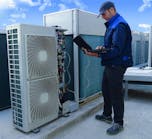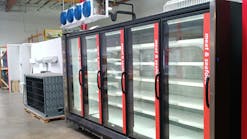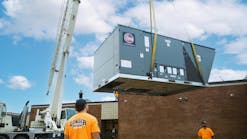by John C. Schaub
You've just received a call from a new client who has a problem with a production chiller. The best way to help begins before you get to the jobsite.
1. The first step is to call the customer and ask for details about what happened, and what indicators or codes come up on the diagnostic readouts (if the chiller has any). If the customer doesn’t know any details, ask him or her to check the following:
- Is the pump circulating the water? What is the water temperature?
- When did the chiller go off-line, and has this happened before? If so, when (could it be the same time every day or same time once a week)?
- Is the chiller running and not cooling, or just not running at all?
These are key items you can use as a troubleshooting starting point before you get to the jobsite. Once on the scene, follow this procedural outline:
2. Check to see whether the information you received over the phone is correct.
3. Once you’ve determined the accuracy of this information, examine the obvious. Is the chiller running? If it’s running, then go the step #8. If it isn’t, look for a diagnostic display panel that can tell you a direction to begin checking. Does the chiller have main power and control power from the transformer? Check all the fuses.
4. Note any codes listed on the chiller (most of the newer chiller units have diagnostic codes or alarm codes to view). Look up the reason in the equipment’s troubleshooting manual. Make sure the company can obtain that for you, even if you know the chiller. Today's newer chillers have a computer's worth of information built into memory.
4a. If the chiller isn’t running, find the electrical diagram of its control and high voltage circuits. This will be very necessary with an older chiller not equipped with built-in diagnostics. The reason a compressor doesn’t engage is usually due to an "open" condition somewhere in the control circuit. You need to find where the open condition resides. Use the electrical diagram to find it.
4b. Start at the power side of the transformer and check wire by wire. On those jobs where you don’t have access to the electrical diagram, or when the chiller is located in a place where you can't read model numbers or see any diagnostic indicator lights or codes, always start at the control transformer and follow the control power wire path. Find the power side, and with a good voltmeter, trace the power wire from safety to safety. Eventually the control power will come to the compressor or pump contactor coil.
Another way to do this is to work backwards from the compressor contactor control coil to the control transformer. It’s along these paths that you’ll find the open circuit, if there is one.
5. If you find an open condition, then you must determine why. It could be anything from low pressure to a broken compressor control module.
Chillers usually have two unique safeties: One is a water flow switch, which can be hidden in the water piping and not be visible, especially if you have a remote pump tank system. The second safety is a freezestat control. A freezestat is basically a back up thermostat that ensures the supply water temperature doesn’t get too cold. Usually freezestats are set 10F less than the supply water temperature the customer wants to run.
6. Make a visual inspection of the chiller electrical panel, water piping, and pump tank system (if it has one). You may be able to see obvious problems such as burned or broken wires, the water pump not running, water valves shut off, and improper system water temperature.
7. At this point, you should have found which safety tripped. Don’t reset it until you have your gauges on the compressor and oil pump (if applicable). Strap temperature probes on the suction, discharge, and liquid lines. Place an amp meter on the high voltage leg of the compressor before you start the system. Reset the safety. Then watch all the pressures, temperatures and amperages at the same time. This is not an easy task, but necessary, especially within the first five minutes. Skip to item #10.
8. Measure the antifreeze concentration in the system. If the system doesn’t have antifreeze, then inspect the water quality. The best way to measure antifreeze is with a refractometer. Remember, if the system uses ethylene or propylene glycol, the freeze point will be different for the same percentages. If you go online to this web address, you can check out a comparison table to see the differences: Go to www.chillers.com/AntifreezeFreezepoints.htm
9. The chiller is running. Great! Now install gauges and temperature probes and begin taking readings. At this point you're ahead of the game, but not out of the woods. You need to find out why the system either tripped a safety or isn’t running the way the customer desires.
Common Chiller Troubleshooting Problems
Following are some common problems that you can troubleshoot, based on the readings from your gauges and probes:
A. Low pressure trip — Caused by low refrigerant, power assembly broken capillary; low or no water flow; clogged water filter or screen; antifreeze or mud coating the tubes of the evaporator causing poor efficiency.
B. High pressure trip — The water-cooled condenser has poor or no flow; water-cooled condenser has mineral buildup due to poor water quality (very common); air-cooled condenser is blocked with debris or has a fan not working; chilled water tank temperature is very high (over 80 F plus).
C. Oil failure trip — Can be caused by either low superheat, low oil (due to a refrigerant leak), or oil pump damage.
D. Freezestat — Poor water flow, or the thermostat is set too low.
E. Blown fuses or starter trips — Shorted or over-amped motor, compressor or wires. Make sure to check for grounds or shorts before you try again.
F. System running but not reaching thermostat setpoint — Evaporator internally iced up, antifreeze breakdown causing poor heat exchange, system load is too great for chiller to handle.
G. Proof of flow — either flow or pressure switches in water circuit are suffering from low or no flow, blocked water filter, water valve shut off, water piping too small, flow switch paddle broken (very common).
Keep in mind that these are common, but certainly not all the problems that can cause a chiller to go offline. It’s always best to remain up-to-date on chiller technology through training. All the major chiller manufacturers offer troubleshooting schools and seminars. All commercial field service technicians should avail themselves of them.








